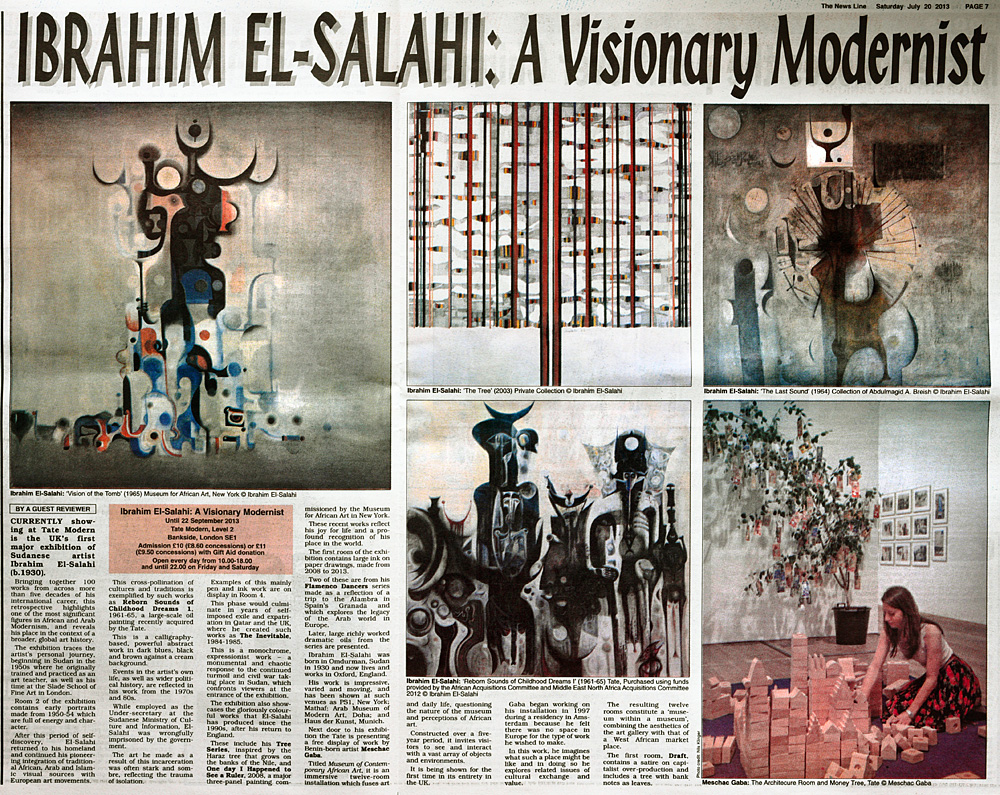 |
| The News Line Saturday July 20
2013 PAGE 7 IBRAHIM EL-SALAHI: A Visionary Modernist BY A GUEST REVIEWER Ibrahim EI-Salahi: A Visionary Modernist Until 22 September 2013 Tate Modern, Level 2 Bankside, London SEl Admission 10 UK pounds (8.60 UK pounds concessions) or 11 UK pounds (9.50 UK pounds concessions) with Gift Aid donation Open every day from 10.00-18.00 and until 22.00 on Friday and Saturday CURRENTLY showing at Tate Modern is the UK's first major exhibition of Sudanese artist Ibrahim EI-Salahi (b. 1930). Bringing together 100 works from across more than five decades of his international career, this retrospective highlights one of the most significant figures in African and Arab Modernism, and reveals his place in the context of a broader, global art history. The exhibition traces the artist's personal journey, beginning in Sudan in the 1950s where he originally trained and practiced as an art teacher, as well as his time at the Slade School of Fine Art In London. Room 2 of the exhibition contains early portraits made from 1950-54 which are full of energy and character. After this period of self-discovery, El-Salahi returned to his homeland and continued his pioneering integration of traditional African, Arab and Islamic visual sources with European art movements. This cross-pollination of cultures and traditions is exemplified by such works as Reborn Sounds of Childhood Dreams 1, 1961-65, a large-scale oil painting recently acquired by the Tate. This is a calligraphy-based, powerful abstract work in dark blues, black and brown against a cream background. Events in the artist's own life, as well as wider political history, are reflected in his work from the 1970s and 80s. While employed as the Under-secretary at the Sudanese Ministry of Culture and information, El-Salahi was wrongfully imprisoned by the government. The art he made as a result of this incarceration was often stark and sombre, reflecting the trauma of isolation. Examples of this mainly pen and ink work are on display in Room 4. This phase would culminate in years of self-imposed exile and expatriation in Qatar and the UK, where he created such works as The Inevitable, 1984-1985. This is a monochrome, expressionist work - a monumental and chaotic response to the continued turmoil and civil war taking place in Sudan, which confronts viewers at the entrance of the exhibition. The exhibition also showcases the gloriously colourful works that El-Salahi has produced since the 1990s, after his return to England. These include his Tree Series, inspired by the Haraz tree that grows on the banks of the Nile, and One day I Happened to See a Ruler, 2008, a major three-panel painting commissioned by the Museum for African Art in New York. These recent works reflect his joy for life and a profound recognition of his place in the world. The first room of the exhibition contains large ink on paper drawings, made from 2008 to 2013. Two of these are from his Flamenco Dancers series made as a reflection of a trip to the Alambra in Spain's Granada and which explores the legacy of the Arab world in Europe. Later, large richly worked dramatic oils. from the series are presented. Ibrahim El-Salahi was born In Omdurman, Sudan in 1930 and now lives and works in Oxford, England. His work is impressive, varied and moving, and has been shown at such venues as PS1, New York; Mathaf: Arab Museum of Modern Art, Doha; and Haus der Kunst, Munich. Next door to his exhibition the Tate is presenting a free display of work by Benin-born artist Meschac Gaba. Titled Museum of Contemporary African Art, it is an immersive twelve-room installation which fuses art and daily life, questioning the nature of the museum and perceptions of African art. Constructed over a five-year period, It invites visitors to see and interact with a vast array of objects and environments. It is being shown for the first time in its entirety in the UK. Gaba began working on his installation in 1997 during a residency in Amsterdam because he felt there was no space in Europe for the type of work he wished to make. In this work, he imagines what such a place might be like and in doing so he explores related issues of cultural exchange and value. The resulting twelve rooms constitute a 'museum within a museum', combining the aesthetics of the art gallery with that of a West African market place. The first room, Draft, contains a satire on capitalist over-production and includes a tree with bank notes as leaves. http://www.wrp.org.uk |